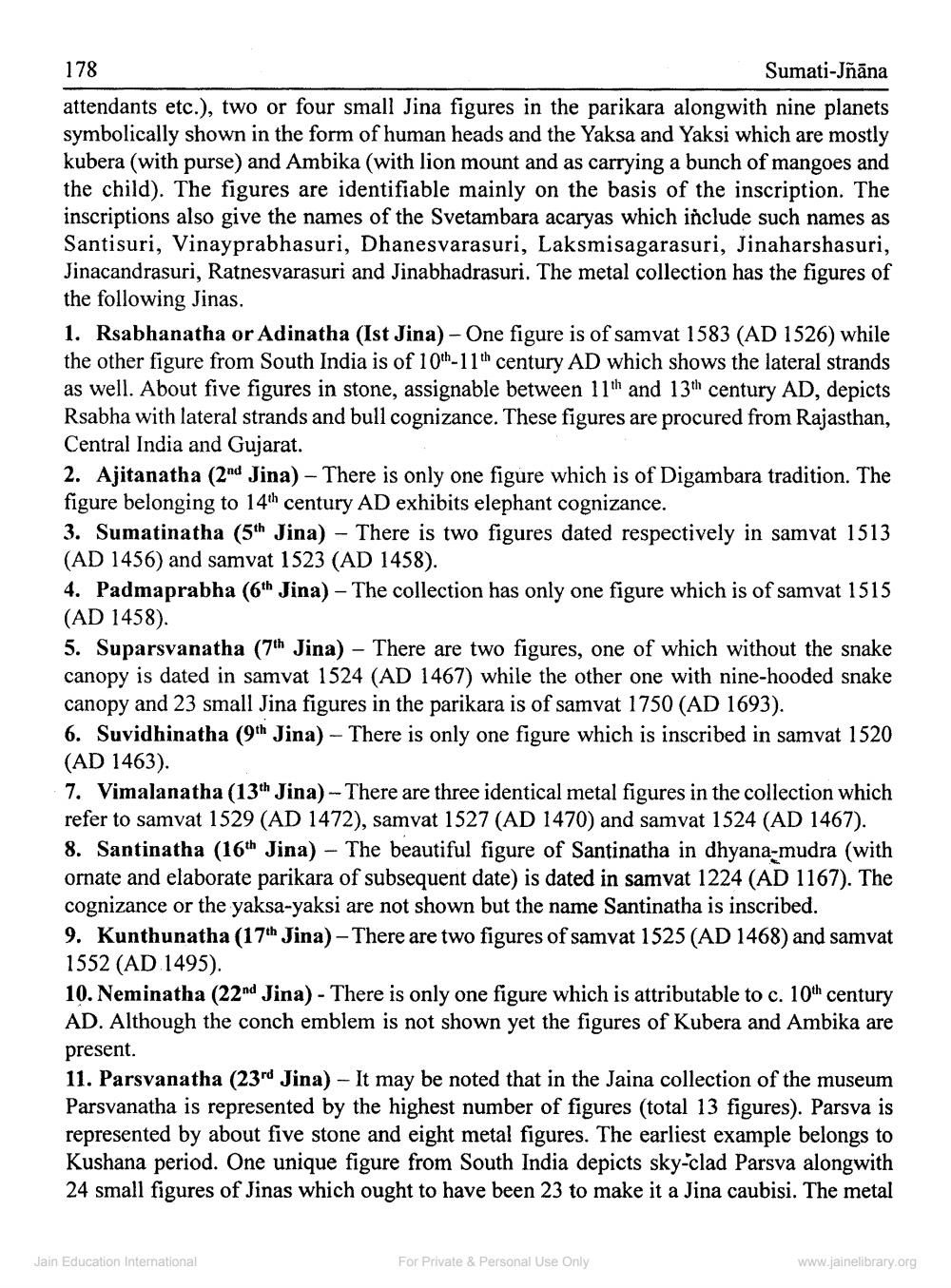________________
178
Sumati-Jñāna attendants etc.), two or four small Jina figures in the parikara alongwith nine planets symbolically shown in the form of human heads and the Yaksa and Yaksi which are mostly kubera (with purse) and Ambika (with lion mount and as carrying a bunch of mangoes and the child). The figures are identifiable mainly on the basis of the inscription. The inscriptions also give the names of the Svetambara acaryas which include such names as Santisuri, Vinayprabhasuri, Dhanesvarasuri, Laksmisagarasuri, Jinaharshasuri, Jinacandrasuri, Ratnesvarasuri and Jinabhadrasuri. The metal collection has the figures of the following Jinas. 1. Rsabhanatha or Adinatha (Ist Jina) - One figure is of samvat 1583 (AD 1526) while the other figure from South India is of 10th 11th century AD which shows the lateral strands as well. About five figures in stone, assignable between 11th and 13th century AD, depicts Rsabha with lateral strands and bull cognizance. These figures are procured from Rajasthan, Central India and Gujarat. 2. Ajitanatha (2nd Jina) - There is only one figure which is of Digambara tradition. The figure belonging to 14th century AD exhibits elephant cognizance. 3. Sumatinatha (5th Jina) - There is two figures dated respectively in samvat 1513 (AD 1456) and samvat 1523 (AD 1458). 4. Padmaprabha (6th Jina) - The collection has only one figure which is of samvat 1515 (AD 1458). 5. Suparsvanatha (7th Jina) - There are two figures, one of which without the snake canopy is dated in samvat 1524 (AD 1467) while the other one with nine-hooded snake canopy and 23 small Jina figures in the parikara is of samvat 1750 (AD 1693). 6. Suvidhinatha (9th Jina) - There is only one figure which is inscribed in samvat 1520 (AD 1463). 7. Vimalanatha (13th Jina) - There are three identical metal figures in the collection which refer to samvat 1529 (AD 1472), samvat 1527 (AD 1470) and samvat 1524 (AD 1467). 8. Santinatha (16th Jina) - The beautiful figure of Santinatha in dhyana-mudra (with ornate and elaborate parikara of subsequent date) is dated in samvat 1224 (AD 1167). The cognizance or the yaksa-yaksi are not shown but the name Santinatha is inscribed. 9. Kunthunatha (17th Jina) - There are two figures of samvat 1525 (AD 1468) and samvat 1552 (AD 1495). 10. Neminatha (22nd Jina) - There is only one figure which is attributable to c. 10th century AD. Although the conch emblem is not shown yet the figures of Kubera and Ambika are present. 11. Parsvanatha (23rd Jina) - It may be noted that in the Jaina collection of the museum Parsvanatha is represented by the highest number of figures (total 13 figures). Parsva is represented by about five stone and eight metal figures. The earliest example belongs to Kushana period. One unique figure from South India depicts sky-clad Parsva alongwith 24 small figures of Jinas which ought to have been 23 to make it a Jina caubisi. The metal
Jain Education International
For Private & Personal Use Only
www.jainelibrary.org




